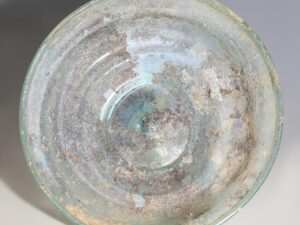The term ‘millefiori’ greatly postdates the antique production of this fragment. Meaning a ‘thousand flowers’, the term was first coined by Italian writers of the Renaissance who wished to convey the all-pervading floral patterns that seemingly dominate this glassware. After its invention in Egypt in the second century BC, the millefiori technique was in fact known as ‘mosaic glass’ by the subsequent Hellenistic and Roman craftsmen who lent their hands to this admittedly complex art form. With the annexation of Ptolemaic Egypt, this glass was particularly favoured by settling Roman elites, and was viewed as a highly desirable commodity.
Millefiori still proves a painstaking glass form, with glassmakers needing firstly to produce smoothened glass rods of different coloured “canes”. It was then fuse into one larger cane and stretched to reduce the size of the imagery and left to cool. The cane was then sliced into small discs and formed into beads or placed across a hot glassware vessel. The vessel would be blown for a second time to merge the pieces of glass and then left to cool in the desired shape.



















